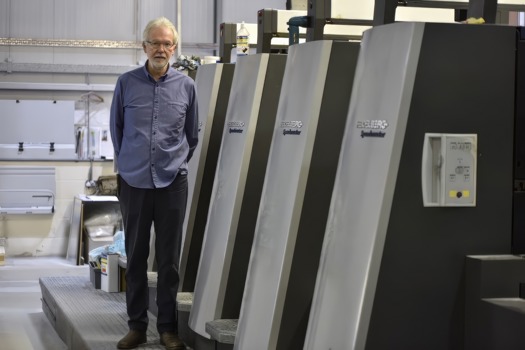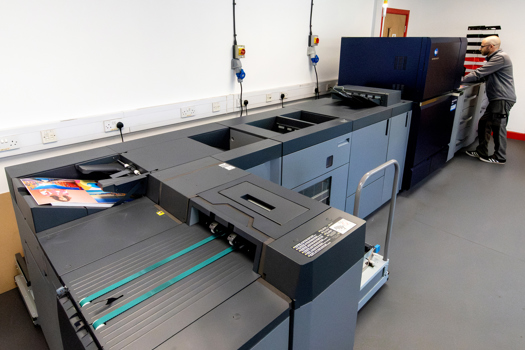As a marketer, print used to be about paper-based substrates. Of course, you could do interesting things with that paper-based substrate, but it was still paper all the same. Not so now. Developments in wide-format print have meant that a whole new world of potential has opened up to marketers, with the capacity to print directly onto everything from snowboards to bike wheels, leather to glass, wood to plastics – the sheer breadth of printable materials is mind-blowing.
The question, however, is how best to use this stunning new capability. The temptation would be to push the technology as far as it can go and to do as much of it as possible. While certainly lucrative for the printer, that is not necessarily the right course of action. To fully understand how to use the new capability of wide-format printing for marketing, you first have to fully understand the context and limitations of that capability.
The key attractions to printing direct on to multiple materials, rather than printing onto a substrate that is then stuck onto other materials, are cost and quality. Until the latest generation of presses came along, printers looking to impose an image on a non-paper surface would typically have to print the image on to an adhesive substrate that would then have to be applied to the intended finished article. This took a lot of time and energy and also required a huge amount of space – to mount a two metre board you might typically need mounting tables that could take up as much as four metres of precious floor space.
However, using direct-to-substrate devices significantly cuts down the amount of processes required to finish a print job, which offers all manner of different savings, says Dominic Fahey, Océ UK’s business group director of display graphics and imaging supplies.
"You no longer have to print media and then mount onto another material, which saves time and reduces ink and media costs because printers don’t have to buy expensive self-adhesive materials," explains Fahey. "Another really important point is that cutting down the processing reduces the risk of mistakes being made. For instance, if an error is made in the mounting – such as a ripple or a crease in the material – you have to start the printing process all over again and that, potentially, can double the costs," he adds.
The finished result when printing direct-to-substrate is also of a better quality and more durable, claims Marchel van der Camp, sign and display marketing manager at HP. "Printing directly to a rigid substrate can often eradicate eventualities like cracking or peeling that may occur when applying a flexible media," says van der Camp.
New markets
One company that doesn’t need convincing of the aforementioned benefits is Tangent On Demand, which invested in a new wide-format direct-to-substrate press earlier this year. Since then the business hasn’t looked back, according to managing director Andy Davis.
"We installed a SwissQprint machine at our site in London’s West End that allows us to print on materials such as wood, metal, glass, cork and so on, and it now produces 35%-40% of our work. It has opened up new markets and opportunities and we are now looking at the next exciting investment," says Davis.
So far Tangent hasn’t found any limitations in terms of the type of substrate the press is capable of printing on – so long as the material is "flat and no thicker than 50mm," it can handle it, adds Davis.
Whether its innovative invites inscribed onto metal or personalised DM shots for a car company on the same material as the dashboard of the car being promoted, marketers are beginning to seize on the technology in a big way. But, according to Mark Stephenson, sales manager of digital solutions at Fujifilm, the emergence of these devices has been truly revolutionary with lots of high-street brands in a more traditional print product: point-of-sale (POS).
"I don’t think it’s an overstatement to say that inkjet has revolutionised POS," says Stephenson. "Especially now that these brands can cost-effectively print their own personalised and regionalised campaigns."
He warns, however, that although the opportunities presented by these new presses are enormous thanks to their ability to print onto virtually any surface imaginable, he argues that just because you can print onto a surfboard or a piece of cork it doesn’t necessarily mean that it’s right for marketers to go down this route.
"Rather than asking ‘what can you print on with wide-format inkjet?’ the real question should be ‘what can’t you print on?’ because as long as you’re combining the right application with the right technology you can print on almost any surface whether it’s glass, boards or floors," says Stephenson. "However, there is a flip side to that argument, which is just because you can print on any surface it doesn’t mean you should do it. There are many factors that need to be considered, such as UV-resistance, scratch- and water-proofing, etc."
For Stephenson the key challenge for printers and marketers is making sure that this type of direct-to-substrate wide-format inkjet printing is being used in the most effective manner possible, not just for the sake of it.
"Take the US, for example. The amount of large-scale banners and signage making up the American landscape can be overwhelming. Now there are restrictions in place to prevent that from happening here in the UK, but it does go to show that marketers should be aware of the best uses of wide-format print," says Stephenson. "Another example that springs to mind is floor graphics, which you find a lot in supermarkets. It’s an inventive idea, but you must also ensure they are being applied properly. For instance, are the graphics adequately scratch-proof? If the surface gets wet could it prove to be a hazard? So there are a lot of things that need to be taken into consideration."
Do more with less
However, if printers and marketers can overcome the sort of hurdles outlined by Stephenson there are numerous benefits that both parties can enjoy, says HP’s van der Camp.
"With marketing budgets typically smaller than in yesteryear, these customers are faced with the need to deliver far more with much less, so they can use it to maximise the attention-grabbing potential of their campaigns," explains van der Camp. "Since inkjet allows for short-run samples and one-off pieces to be produced quickly and cost-effectively as test projects, marketers can also experiment with different substrates and techniques without incurring huge outlay."
Indeed the only limitation when it comes to using wide-format direct-to-media devices is the extent of one’s imagination says Marc Verbiest, international public relations manager at EFI. At Drupa, the press manufacturer showed what its devices are capable of by printing onto guitars, but this is just the tip of the iceberg when you consider some of the jobs its clients are producing, says Verbiest.
"Life Art in the Netherlands uses an EFI Vutek to print directly on to environmentally friendly fibreboard to make coffins and WTO, a German printer, uses the Jetrion 4900 to print labels for gas cylinders that must withstand harsh outdoor conditions," says Verbiest. "The market is very diverse. The use of inkjet for small-scale materials, such as labels and ceramic tiles, is growing very rapidly. Digital inkjet printing is fast replacing multi-step processes, such as flexography."
And the good news is that printers – famously poor at selling their wares – appear to have got to grips with how to sell this new service to their customers.
"One of our earliest adopters of this technology was a litho customer who decided to print on all sorts of substrates and objects before sending them out to marketers to show what could be achieved and the response was extremely positive," says Fujifilm’s Stephenson.
Van der Camp says the press manufacturers’ clients have been similarly inventive in their sales approach.
"A printer in Ireland recently told me how, having gathered some customers at his print facility, he took a tile from his ceiling, ran it through his HP Scitex FB500 and printed their logo and branding before re-installing it all in the space of a few minutes. Using such impromptu and quirky methods works wonders at captivating customers and hammering home the many number of objects that can be printed to."
So with printers pushing it and marketers that know about it seemingly very keen to employ the technology, it seems like printing direct to multiple substrates is going to grow and grow. As some above have noted, caution is going to be important to ensure the market is not flooded with pointless uses of the technology, and some more education has to be done to make sure all marketers are fully aware of the capabilities, but overall the new capacity to print onto pretty much anything looks set to bring printers and marketers even closer together in the pursuit of effective and innovative marketing collateral









